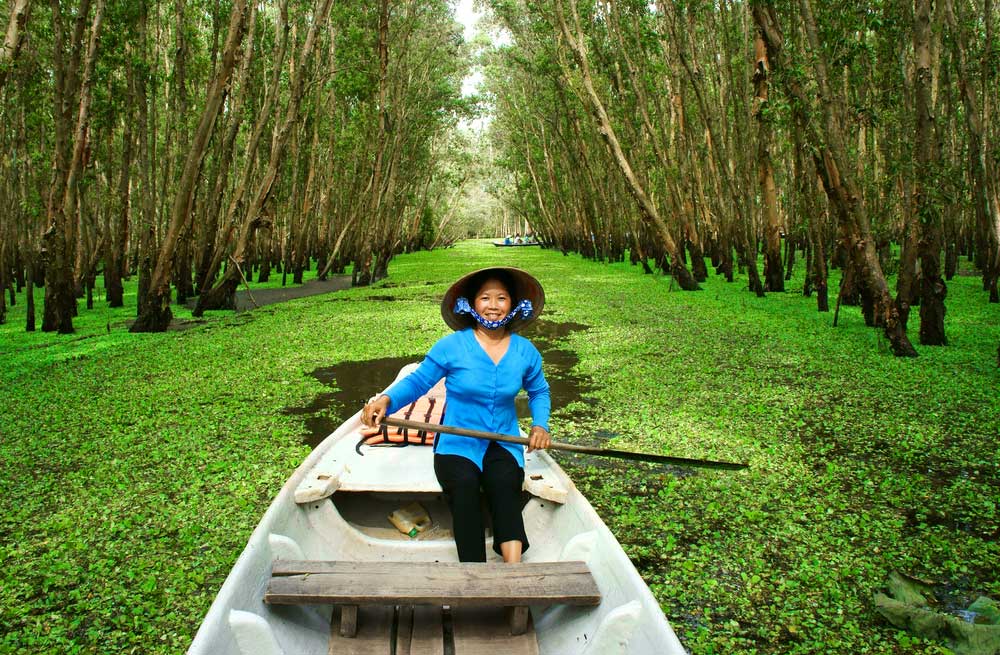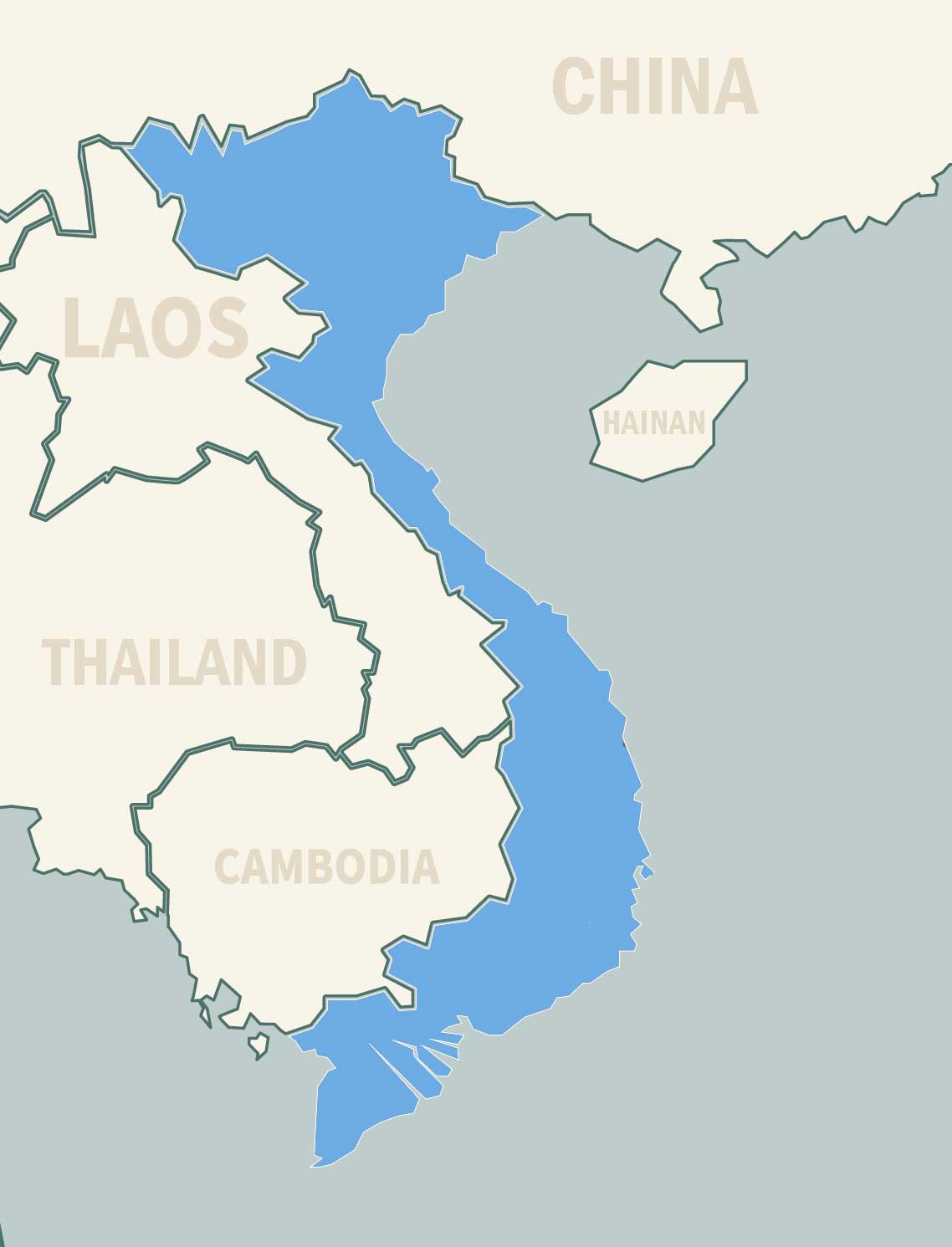Sapa
Located 1,500 metres above sea
level in Vietnam’s remote northwest
mountains, Sapa is famous for
its rugged scenery, luscious rice
fields and rich ethnic and cultural
diversity. Close to China, this
picturesque town is home to many
ethnic groups, who can be seen
around the town in their colourful,
traditional clothing.
Hanoi
Hanoi, the capital, is a rich city
featuring mazes of winding, narrow
lanes full of shops, taverns, cyclos and motorbikes. The city centre is an architectural museum piece, featuring blocks of colonial-style buildings retaining the air of a peaceful and austere provincial town. Stroll around in the old quarters near Hoan Kiem Lake for a peaceful oasis in the middle of the bustling metropolis.
Halong Bay
This UNESCO World Heritage Site is considered by many to be one of Natural Wonders of the World, and for good reason. Over 2,000
magnificent limestone karsts rise from the clear, emerald waters of the Gulf of Tonkin, making for a truly picturesque scene not to be missed. The limestone basin reveals stalactite caves, crescent beaches and odd-shaped formations. It is also famous for its varied ecological system housing thousands of fish species, along with hundreds of coral and other sea creatures.
Ninh Binh
Ninh Binh is considered by some to be a “dry
Halong Bay,” known for its limestone hills and
meandering river taking you through three caves
before entering a secluded valley. Here, the river
merges seamlessly into rich green rice fields, and
farmer’s dwellings can be seen, clinging to the
cliffs tending to its rocky outcrops. As you make
your way through the river, keep an eye out for
plunging Kingfishers or nimble-footed mountain
goats silhouetted against the skyline and rough
stone.
Hai Phong
Hai Phong is a large trading gateway in the
Northern part of the country. The Chinese,
Japanese, French, Spanish and Portuguese
have been trading here for centuries.
Nowadays it’s a commercial centre with an
important transportation hub. Moreover,
visitors can enjoy beautiful landscapes as
well as unique festivals celebrated on Cat
Ba Island and Do Son Beach.
Danang
Danang’s origin dates back to the ancient Champa Kingdom, established by Indonesian settlers in 192 AD. However, nowhere in Vietnam has changed as fast as Danang. Along the waterfront, you will find new modernist hotels, spectacular bridges, and new beachside developments emerging. Located directly on the coast with fabulous beaches, it is an ideal base to begin exploring both Hoi An and Hue city.
Hue
This quaint riverside town was once the
principal port of the Cham Kingdom.
Beautiful, steeped in history and culture,
this UNESCO World Heritage Town is
very popular with visitors, and for good
reason. Just 30km south of Danang, Hoi
An was one of the major trading centres of
southeast Asia in the 16th century. Hoi An
has retained a distinct Chinese atmosphere
with low, tile-roofed houses and narrow
streets. Ancient houses are made of
rare wood, decorated with lacquered
boards and panels engraved with Chinese
characters; pillars are also carved with
ornamental designs.
Hoi An
This quaint riverside town was once the principal port of the Cham Kingdom. Beautiful, steeped in history and culture, this UNESCO World Heritage Town is very popular with visitors to Vietnam, and for good reason. Just 30km south of Danang, Hoi An was one of the major trading centres of southeast Asia in the 16th century. Hoi An has retained a distinct Chinese atmosphere with low, tile-roofed houses and narrow streets. The original structure of some of these streets remains intact. All the houses were made of rare wood, decorated with lacquered boards and panels engraved with Chinese characters; pillars were also carved with ornamental designs. Tourists can visit the relics of the Sa Huynh and Cham cultures and enjoy sunset strolls along the romantic Hoi An River, Cua Dai Beach and Cham Island.
Cam Ranh
This up-and-coming beach town in South Central
Vietnam is located on picturesque Cam Ranh Bay. The
international airport boasts a new terminal, and is a
gateway to nearby Nha Trang. But despite this easy
access, Cam Ranh still feels like an undiscovered whitesand
beach, which is exactly its charm.
Visit Tu Van Pagoda built almost entirely from shells
and coral. Or take a boat out to explore tiny Binh Hung
island opposite Cam Ranh Bay. Play golf, learn to surf,
get up early for sunrise yoga on the beach, or just relax
at your hotel spa. There is something for everyone.
Nha Trang
Pure, white sandy beaches and clear
blue waters make Nha Trang the best
place in Vietnam for swimming and
scuba diving. Spend time touring the
ocean by boat, visiting fishing villages
and eating delicious, fresh seafood.
Other than its seaside area, guests can
take a bicycle ride along the beachfront
boulevard to the city’s market and to
the ancient Cham towers of Po Nagar
to see a full view of the coast. A vibrant
night scene with a diverse range or bars
and restaurants mean this town has
something to suit all tastes.
Dalat
Located in the South central highlands,
Dalat is a slice of Europe tucked away
in the rolling hills of Southern Vietnam.
It was originally a getaway for the
French, who built villas to escape the
heat and humidity off the coast and
in Saigon. Dalat’s colourful market
features locally made specialities such
as artichoke tea, candied fruits, coffee
and the finest cool climate vegetables
and flowers in Vietnam.
Phan Thiet
Often overlooked by travellers, Mui Ne is a charming beach town that is ideal for beach goers and kite surfers alike! Golfers will enjoy the Ocean Dunes, a classic course set amid a stunning surrounding. Phan Thiet is located 200km from Saigon along Vietnam’s southeastern coast;
and is home to one of the best stretches of beach in the country. Phan Thiet has retained its fishing village culture despite a myriad of resorts that have opened on coast of Mui Ne.
Mekong Delta
The Mekong Delta offers travellers
the opportunity to experience rural
Vietnam and a way of life little changed
over centuries. Travel by sampan along
narrow cancels to tropical fruit orchards
and bonsai gardens; sample freshly
picked fruits and the local delicacy,
friend elephant-ear fish; and navigate
the winding waterways and exlpore the
area’s famed floating markets.
Phu Quoc
Surely the most beautiful island in Vietnam, Phu Quoc is
surrounded by white sand beaches and a dense jungle in the
centre. Long Beach is refined, Ong Lan Beach romantic, and Bai
Sao simply irresistible. With 37,000 hectares of forest, it is home
to assorted rare plants and birds. Phu Quoc is called the ‘Pearl
Island’ because high quality, large pearls can be found there. Enjoy
both sun and steam baths, climb up to caves or venture deep into
the forest where you can enjoy nature and wildlife.
Ho Chi Minh City
Saigon is Vietnam’s most progressive and bustling
city, buzzing with activity all hours of the day. French
colonial buildings and historic landmarks and museums
are highlights of this rapidly developing city. The city is
crammed full of restaurants and bars ranging from simple
pavement stalls where you can buy a bowl of noodles
on the cheap, to sophisticated restaurants serving
fine European cuisine. Ho Chi Minh’s nightlife is very
cosmopolitan, and there are literally hundreds of bars,
pubs, nightclubs and discotheques to explore. It is also a
real shopper’s paradise with modern shopping centres and
trendy boutiques situated near traditional street markets.






